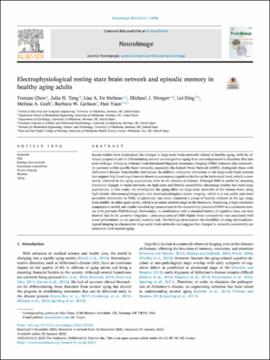| dc.contributor.author | Chen, Yuxuan | |
| dc.contributor.author | Tang, Julia H. | |
| dc.contributor.author | De Stefano, Lisa A. | |
| dc.contributor.author | Wenger, Michael J. | |
| dc.contributor.author | Ding, Lei | |
| dc.contributor.author | Craft, Melissa A. | |
| dc.contributor.author | Carlson, Barbara W. | |
| dc.contributor.author | Yuan, Han | |
| dc.date.accessioned | 2022-09-02T21:10:47Z | |
| dc.date.available | 2022-09-02T21:10:47Z | |
| dc.date.issued | 2022-06 | |
| dc.identifier.uri | https://hdl.handle.net/11244/336523 | |
| dc.description.abstract | Recent studies have emphasized the changes in large-scale brain networks related to healthy aging, with the ultimate purpose to aid in differentiating normal neurocognitive aging from neurodegenerative disorders that also arise with age. Emerging evidence from functional Magnetic Resonance Imaging (fMRI) indicates that connectivity patterns within specific brain networks, especially the Default Mode Network (DMN), distinguish those with Alzheimer's disease from healthy individuals. In addition, disruptive alterations in the large-scale brain systems that support high-level cognition are shown to accompany cognitive decline at the behavioral level, which is commonly observed in the aging populations, even in the absence of disease. Although fMRI is useful for assessing functional changes in brain networks, its high costs and limited accessibility discourage studies that need large populations. In this study, we investigated the aging-effect on large-scale networks of the human brain using high-density electroencephalography and electrophysiological source imaging, which is a less costly and more accessible alternative to fMRI. In particular, our study examined a group of healthy subjects in the age range from middle- to older-aged adults, which is an under-studied range in the literature. Employing a high-resolution computation model, our results revealed age associations in the connectivity pattern of DMN in a consistent manner with previous fMRI findings. Particularly, in combination with a standard battery of cognitive tests, our data showed that in the posterior cingulate / precuneus area of DMN higher brain connectivity was associated with lower performance on an episodic memory task. The findings demonstrate the feasibility of using electrophysiological imaging to characterize large-scale brain networks and suggest that changes in network connectivity are associated with normal aging. | en_US |
| dc.description.sponsorship | This study was supported by National Science Foundation RII Track-2 FEC 1539068, Oklahoma Center for the Advancement of Science & Technology HR16–057, and Institute for Biomedical Engineering, Science, and Technology at University of Oklahoma. Financial support was provided by the University of Oklahoma Libraries’ Open Access Fund. | en_US |
| dc.language | en_US | en_US |
| dc.rights | Attribution-NonCommercial-NoDerivatives 4.0 International | * |
| dc.rights.uri | https://creativecommons.org/licenses/by-nc-nd/4.0/ | * |
| dc.subject | EEG | en_US |
| dc.subject | Resting state network | en_US |
| dc.subject | Functional connectivity | en_US |
| dc.subject | Source imaging | en_US |
| dc.subject | Memory | en_US |
| dc.subject | Aging | en_US |
| dc.title | Electrophysiological resting state brain network and episodic memory in healthy aging adults | en_US |
| dc.type | Article | en_US |
| dc.description.peerreview | Yes | en_US |
| dc.identifier.doi | 10.1016/j.neuroimage.2022.118926 | en_US |
| ou.group | Gallogly College of Engineering::School of Electrical and Computer Engineering | en_US |


